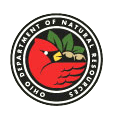Wildlife Officials Caution Well-Meaning Citizens to Keep the Wild in Wildlife

COLUMBUS, OH – -(AmmoLand.com)- In the spring and early summer, when wildlife reproduction is at its peak, you may discover a nest of young birds or rabbits, a fawn or another wild animal with no adult in sight. Enjoy the scene, but leave them alone! Wildlife parents are very devoted to their young and rarely abandon them. If taken from their natural habitat, young animals have little chance of surviving.
The Ohio Department of Natural Resources (ODNR) Division of Wildlife staff, Ohio Wildlife Rehabilitators Association (OWRA) members, and licensed wildlife rehabilitators have worked hard to reduce the number of wild animals being picked up by well-meaning people. This has been especially true for white-tailed deer fawns. A fawn alone and hidden in a meadow, woodland edge, or even a backyard flower garden is most likely not an orphan. The doe deer often leaves her young alone in an out-of-the-way spot when she is off feeding. Since the doe cannot be in two places at once, a fawn may be left alone several times a day.
“The Division of Wildlife and wildlife rehabilitators share a common goal to be good stewards and ensure healthy wildlife populations exist for future generations to enjoy,” stated David M. Graham, chief of the Division of Wildlife.
Beginning in 2009, the Division will not authorize the rehabilitation of white-tailed deer fawns in order to help reduce the possible spread of communicable diseases, such as Chronic Wasting Disease (CWD). This is only one proactive approach being employed to minimize the risk of CWD being introduced into the state and unknowingly moved from one location to another, thereby jeopardizing the health of Ohio’s 700,000 wild white-tailed deer. While CWD has been detected in West Virginia and Michigan, it has not been detected in Ohio since statewide testing began in 2002.
CWD is a progressive, fatal, degenerative disease of the brain affecting elk, mule deer, white-tailed deer and moose. There is no evidence that CWD affects humans. It is not certain how the disease is transmitted, but it appears that animal-to-animal and mother-to-offspring transmission may be possible. The most likely means of transmission is between animals that are in close contact with each other.
The Division and the OWRA advise people to leave fawns alone. In cases where a fawn is taken to a wildlife rehabilitator the fawn will need to be returned to the location where it was found by the person who picked it up or by the rehabilitator. In situations where fawns are picked up from known dead does, these fawns could be released within the same township in an area where the rehabilitator feels a doe might adopt the orphan.
“We should always keep in mind that the goal of wildlife rehabilitation is to return native wildlife back to the wild, and that our actions and activities should never jeopardize wildlife populations,” said Betty Ross, president of the OWRA. To learn more about the OWRA visit their Web site at www.owra.org.
Along with the warning to leave young and injured wildlife alone, the ODNR Division of Wildlife offers the following advice:
Think before you act. Check for nests before cutting down trees or clearing brush. It is best to cut trees and clear brush in the autumn when nesting season is over.
Use common sense. If you disturb a nest, replace the animals and the nest material to the original location or as close as possible. If you find a fawn, leave it where you find it. The doe has likely hidden it there and will be returning to feed it, usually after dark.
Keep pets under control so they do not raid nests and injure wild animals. Keep pets vaccinated against parasites and diseases.
Educate children to respect wildlife and their habitat. Emphasize to your children not to catch, handle or harass wild animals. Practice what you preach.
Contact your local wildlife officer or wildlife district office before taking action. Trust and follow the advice of these trained professionals.
About:
The Ohio Department of Natural Resources ensures a balance between wise use and protection of our natural resources for the benefit of all. Visit the ODNR web site at www.ohiodnr.com.
